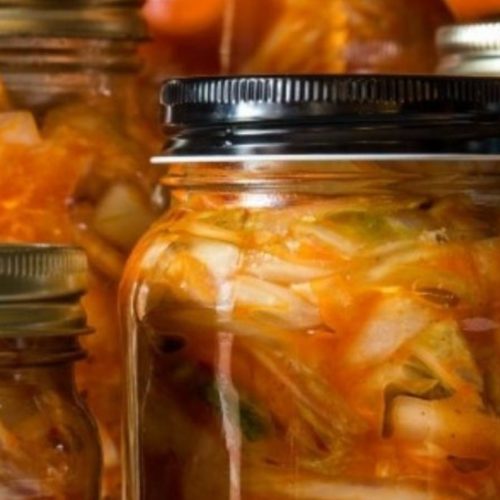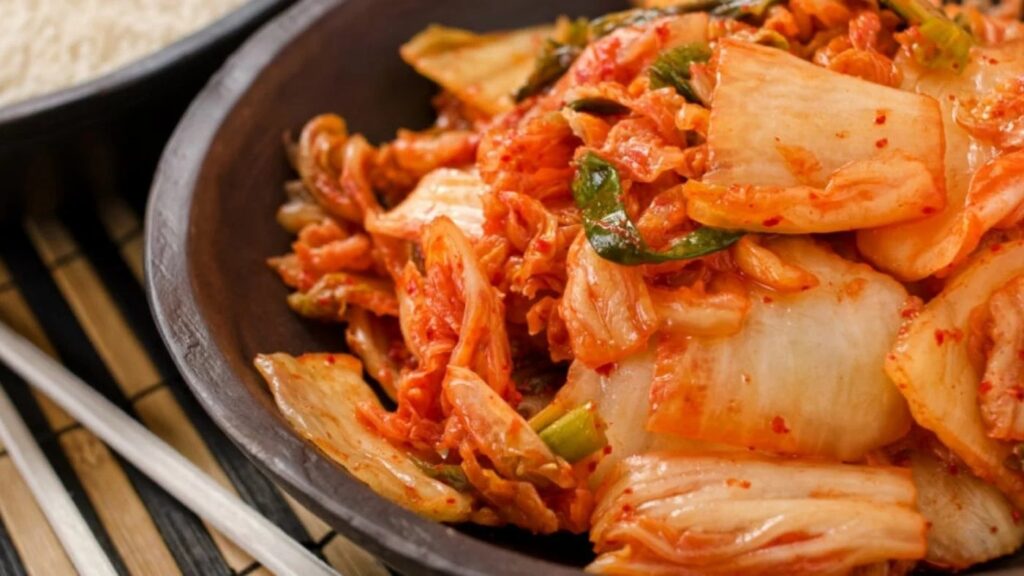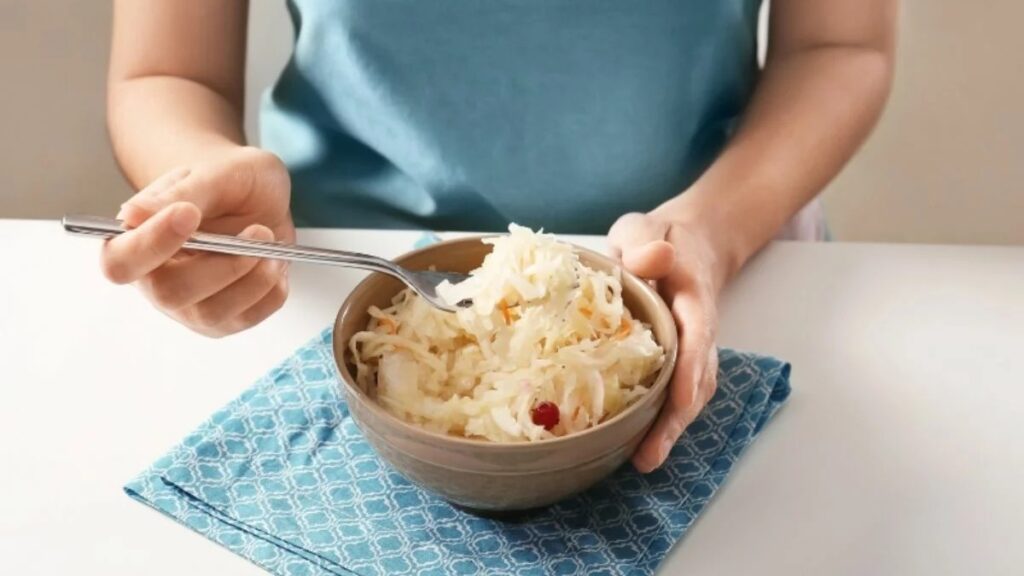Kimchi is a fermented condiment that’s easy to make at home. With a few fresh vegetables and some simple steps, you can make delicious homemade kimchi!
This article gives you all the information you need to make a successful homemade kimchi recipe.
Go straight to the section that interests you:
- What is kimchi?
- Equipment
- Ingredients
- Traditional Korean kimchi recipe
- How to eat kimchi?
- Frequently asked questions
What Is Kimchi?
Kimchi is a spicy vegetable mixture that has been fermented – a kind of spicy sauerkraut! It has been prepared for hundreds of years in Korea, where it is served with almost every meal. As the Korean saying goes: “A meal without kimchi is no meal at all”.
The vegetables traditionally found in kimchi are:
- Napa cabbage
- Daikon radish
- Carrots
- Onions or scallions
Several herbs are added, such as:
- Garlic
- Ginger
- Fish sauce
- Korean chili flakes (gochugaru)
However, the ingredients, proportions, and aromatics vary from recipe to recipe. Every Korean house has its own kimchi recipe! Whether it’s radish-based kimchi, kimchi without chilies (white kimchi), vegan kimchi… To each his own!
To find out more, read our articles:
- What is kimchi, and why do we eat it?
- The benefits of kimchi according to science
- 9 amazing facts about kimchi

What Is Kimchi Fermentation?
Vegetables are tasty. Fermented, they become exceptional! Fermented vegetables are not only easier to digest and tastier, they’re also better for your health.
Lacto-fermentation (also known as lactic fermentation) turns simple vegetables into delicious kimchi.
This process uses lactic acid bacteria naturally present on the vegetables. These bacteria consume the sugar in the vegetables and create lactic acid. This is what gives fermented vegetables their tender texture and tangy flavour.
All that’s needed for fermentation to work properly is salt and an oxygen-free environment. Simply mix vegetables and salt and put them in a sealed jar!
For everything you need to know about fermenting vegetables, see the Complete Guide to Lacto-Fermentation.
Equipment for Making Kimchi
To successfully make kimchi, you’ll need three things:
- A jar
- A weight to prevent the vegetables from being exposed to air
- A lid that lets out the fermentation gas
For this Korean kimchi recipe, we use glass jars with screw lids (Mason jar type). However, Le Parfait type jars would be a great alternative.
We recommend using a weight such as a glass weight or a ViscoDisc insert.
There are also several other all-in-one options for making kimchi at home, such as the Revolution Fermentation complete kimchi making kit or the Crazy Korean Cooking container.
To find out more about the equipment to use, see How to choose your lacto-fermentation equipment!

Kimchi Ingredients
Kimchi is made with simple, easy-to-find ingredients.
Vegetables
Choose fresh, firm vegetables. Although we suggest organic ones, this is not a requirement.
Napa cabbage, daikon radish, onions, and carrots are easy to find in supermarkets or Asian grocery stores. All these vegetables are also available from a growing number of local market gardeners.
If necessary, napa cabbage can be replaced by bok choy or even green cabbage.
Aromatics
Traditional kimchi recipes use seafood or dried prawns to give it a strong flavour. We suggest using fish sauce instead, which is easier to find and just as rich in flavour!
For a vegan alternative, use soy sauce, coconut aminos, or dried seaweed, as in our vegan kimchi recipe.
To intensify the flavours, fresh garlic and ginger can be chopped or ground before adding to the mixture. We prefer to use them fresh rather than in powder form.
Korean chili (gochugaru) gives kimchi a distinctive colour and flavour. You can buy gochugaru online or in Asian grocery stores.
Salt
Salt is essential for fermentation. For every kilogram of vegetables, allow 20 g of salt (1 large tablespoon).
The salt you use must be free of additives and anticaking agents. The only ingredient should be “salt”!
To find out more, see Best Salt for Fermenting Vegetables?
Lactic Acid Bacteria
No need to add bacteria to your kimchi, vegetables already contain them! Trust the process 😀
If, however, you want to ensure optimal fermentation, you can add Caldwell’s Starter Culture for Fresh Vegetables.

Different Steps in Preparing Kimchi
There are 4 steps to preparing kimchi.
Preparing the Vegetables
This stage is no more complicated than making a salad: remove the damaged parts and cut the vegetables into pieces.
Mix with Salt
In a large bowl, toss all the ingredients with salt (dry salting) to help the vegetables soak. Leave for 15 minutes to allow the water to drain from the vegetables. This will make it easier to fill the jars.
Putting in Jars
Place the vegetables in the jars, compressing them.
Then, to avoid contact with the air, add a weight to keep the vegetables submerged in their own liquid, and close the jars. If the lid is screwed on, do not tighten it too much to allow the gas to escape, but enough to prevent oxygen from entering.
Let them Ferment
The jars are left at room temperature on a large plate to catch any spillage.

Homemade Kimchi Recipe
Equipment
- 4 Le Parfait 500 ml jars (or 500 ml Mason jars)
- 1 Large mixing bowl
- 1 chopping board
- 1 Knife
- 1 fermentation tamper (optional)
Ingredients
- 1 kg Chinese cabbage, napa cabbage or bok choy...
- 300 g daikon or other radishes
- 200 g carrot
- 200 yellow onion
- 20 g Korean chili flakes (gochugaru)
- 2 garlic cloves
- 10 ml fresh ginger
- 35 g sea salt (or the equivalent weight of 2% of the total)
- 15 ml dried fish or prawn sauce
Steps
Preparing the Vegetables
- Cut the cabbage and onion into small pieces.
- Grate the daikon and carrot.
- Finely chop the garlic and ginger.
- Mix all the ingredients in a large bowl with your hands, crushing the vegetables (about 1 minute).
- Let them soak for at least 15 minutes. Mix again for 1 minute.
Putting Into Jars
- Place the vegetables in the jars. Compress well as you go.
- Add an insert and close the jar.
Fermentation
- Place the jars on a tray (or plate) in case the juice overflows during fermentation.
- Leave to ferment for about 5 days.
- Once opened, store in the fridge. If left unopened, a jar of kimchi can remain at room temperature for many weeks but will continue to ferment.
Notes
Get started easily!
Complete Kimchi Making Kit
$58.00
Prepare delicious homemade kimchi with our complete kimchi fermentation kit!
Shop nowHow to Eat Kimchi
In Korea, kimchi is served as a condiment with rice, stews, grilled meats, vegetables, and so on.
You can eat it as a condiment, or add it to your recipes:
- Rice bowl with kimchi (bibimbap)
- Kimchi burgers
- Kimchi sandwich or wrap
- Fried rice with kimchi
- Grilled cheese with kimchi
- Kimchi ramen
And so much more! For more ideas, check out our article How to Eat Fermented Vegetables: 44 Delicious Ideas.
How to Store Kimchi
Thanks to fermentation, kimchi keeps for at least a year in the fridge. Over time, its flavour improves!
However, you need to follow a few basic rules:
- Once opened, keep the jar of kimchi in the fridge.
- Always close the lid tightly after use.
- Use clean utensils to remove the kimchi.
- Do not put kimchi that has been taken out of the jar back in.
Frequently Asked Questions
Why Do Some Kimchi Recipes Soak the Vegetables in Brine?
It is not necessary to soak the vegetables before fermenting them.
The traditional method of preparing kimchi involves soaking the vegetables in very salty water. This tenderizes the vegetables and facilitates fermentation. We mimic this technique by massaging with salt (dry salting).
This technique is very useful when fermenting dozens of whole cabbages, and you want to tenderize them easily so you can put herbs and spices between each leaf.
To prepare a few jars of kimchi, this step is unnecessary and even problematic, as you end up wasting a lot of salt.
How Do You Make Vegan Kimchi?
Making vegan kimchi is easy and delicious!
Simply replace the fish sauce with another ingredient rich in “umami”:
- Soy sauce
- Miso
- Coconut aminos
- Seaweed
- Mushroom broth
To find out more, discover our vegan kimchi recipe.
How Do You Make Kimchi Without Chili?
To make kimchi without chili, simply don’t add any chili. This type of kimchi is called “white kimchi” or “baek-kimchi“. White kimchi is milder than traditional kimchi, but just as delicious.
Although chili adds a lot of flavour and spice to kimchi, your fermentation will still be successful and delicious without it.
With What Can I Replace Korean Gochugaru Chili?
Korean chili pepper (gochugaru) has a fragrant, slightly smoky flavour. It adds just the right amount of spiciness to kimchi.
It can be found in dry format, either as a powder or in small flakes.
It can be replaced by paprika, chili flakes, or cayenne pepper. It’s less traditional, but it’s still spicy!
Are There Any Risks Involved in Making Kimchi?
Making kimchi is an easy and safe process. By following the steps and keeping a clean work environment, making kimchi is safe.
To find out more, see Is Lacto-Fermentation Safe?
How Long Does Kimchi Take to Ferment?
The fermentation time for kimchi can vary from a few days to several weeks. Either way, it will be safe to eat and delicious.
After 5 days of fermentation, the kimchi will be slightly acidic and firm.
After several weeks, it will be more acidic and tender.
If you put it in the fridge, fermentation will slow down, but the kimchi will continue to mature.
Why Did My Kimchi Overflow From the Jar?
During fermentation, carbon dioxide is created. This gas tries to escape from the jar, causing the liquid to rise and, if it’s close to the rim, to overflow.
Place the jars on a large plate and wipe up the spill as you go along. CO2 production should subside after a few days.
Is My Kimchi Successful?
A successful kimchi is easy to identify:
- Tangy taste
- (Sometimes) bubbles in the jar
- Smell of marinade
A failed kimchi is easy to identify:
- Visible, hairy mould on the surface
- Strong smell of garbage
For more information, check out our Frequently Asked Questions About Fermented Vegetables.
Get Started!
- Discover the Revolution Fermentation kimchi kit
- Buy a Crazy Korean Cooking fermentation container
- Buy lacto-fermentation supplies
- Read our complete guide to lacto-fermentation
- Discover our fermented vegetable recipes


